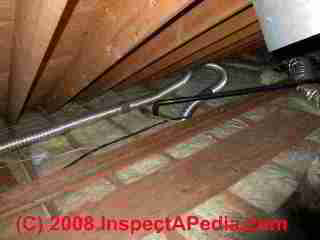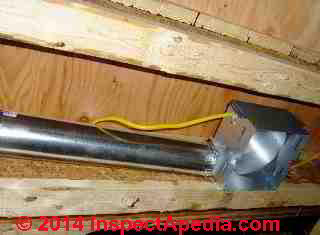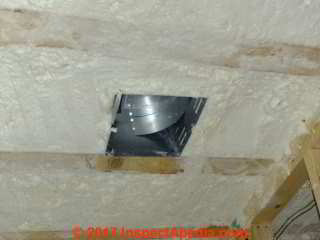 Bath Exhaust Fan Duct Insulation
Bath Exhaust Fan Duct Insulation
Why & how should we insulate the exhaust duct on a bathroom exhaust fan system?
- POST a QUESTION or COMMENT about insulating bath vent ducts
Bath Exhaust Fan Duct Insulation:
How should we insulate the exhaust duct on a bathroom exhaust fan system to prevent condensation and leaks into the building or wall?
This article series explains how to install bathroom exhaust fans or vents, the vent ducting, the vent termination at the wall, soffit or roof, vent fan wiring, bath vent duct insulation, bath vent lengths, clearances, routing, and we answer just about any other bathroom ventilation design or installation question you may have.
InspectAPedia tolerates no conflicts of interest. We have no relationship with advertisers, products, or services discussed at this website.
- Daniel Friedman, Publisher/Editor/Author - See WHO ARE WE?
Bathroom Vent Fan Ductwork Insulation
Insulate the bathroom exhaust vent fan ducts: In un-conditioned space such as an attic, where otherwise your fan duct will be exposed to cold attic air in winter, use insulated solid metal ducting or insulated flex duct.
We insulate the bath vent ductwork to minimize the condensation that will otherwise occur as warm moist bathroom exhaust air passes through cool ductwork in the building attic or roof cavity.
Our photo above shows a long routing of bath vent fan ducts across an attic floor to an exit at the building soffit or eaves and the condensation of moisture in such vent lines.
These ducts should be insulated (or replaced with pre-fab insulated ductwork or flexduct), and a better installation would have shortened that very long duct as much as possible, exiting to a soffit closer to the bathroom.
Above we illustrate bath exhaust vent ducting before and after it is covered by a spray foam insulation job in a cathedral ceiling.
Watch out: we do not recommend purchasing vent ducts with insulation on the duct interior.
Although fiberglass-lined HVAC ducts are widely used in heating and air conditioning systems as well as in heat recovery ventilator systems, for a standard bath exhaust fan vent duct, the combination of permeable fiberglass or other insulating material and very high moisture levels is asking for mold or other trouble inside the vent line.
FAQs on Bathroom Vent Duct Insulation
On 2017-11-26 by (mod) -
What are two common sources for cold air falling out of a bathroom fan opening in cold weather.
The first is wind-blown drafts entering at the vent termination opening. Cure for that is to purchase a properly soft closing vent termination.
The second is not caused by outside air movement or wind but rather falling of cold air out of a cold attic vent back into the occupied space. A phenomenon occurs more often with poorly insulated HVAC vents but it can also occur if there is sufficient vertical rise above the bathroom exhaust vent.
On 2017-11-26 18:11:44.076261 by Bob
I had a new house built with a bathroom vent. The duct work travels vertical for 1 ft and then travels horizontal for 17 feet through an unheated attic to a soffit vent. Leaks in cold weather through the vent grill in the bathroom. Replaced the metal flex with solid metal duct, insulated the duct and vent box area in the ceiling with batt insulation. I also replaced the vent fan with the proper CFM requirements. It leaks more now than ever. What I do now? Also, to eliminate the steam during showers, I keep the bathroom door 3/4 open.
On 2017-06-28 by Ron Cote
I had a bathroom exhaust fan installed in my upstairs bathroom and was vented through the attic to the outside with flex duct not insulated,In the cold weather I saw moisture on roof cavity and mold on roof cavity. the Company that installed it says it is installed properly. Who do i have check out the installation
On 2017-06-23 by Joel
Dan, Thanks! Love the work. I'm working on replacing the bath fan and duct in my 2-story townhouse, so it looks like my options are routing it through the roof or through the soffit.
My plan is to go to the soffit. 2 questions:
1) The previous fan had a 3-in aluminum duct routed to the ridge cap vent. I'm getting rid of it since my new fan has a 4-in exhaust port, but was that an ok way to go?
2) The fan housing sits between joists, and in about 12 inches of blown-in insulation. Can I just take an uninsulated duct and bury it in the blow-in insulation out to the soffit?
On 2017-05-06 by (mod) - external insulation can also mitigate noise in HVAC systems
Thanks Hugh, good point. Though external insulation can also mitigate noise in HVAC systems. Another form of fiberglass " lined" HVAC ducts uses simple foil-faced fiberglass panels - making for lightweight, easy to build ductwork that can still be damaged by aggressive mechanical cleaning.
Bathroom vent fans usually use metal ductwork or in some older homes flexible plastic (no longer recommended) - distinct from HVAC ductwork and not exposing fiberglass to the duct interior.
Terry,
I don't understand the question; perhaps a photo sent via our page top /bottom CONTACT link would permit comment.
On 2017-05-06 by Hugh
Note that fiberglass-lined HVAC ducts are motivated to control noise from upstream equipment and/or air velocity/turbulence in the ductwork. There are better ways to address this for moisture-laden residential bath ventilation.
On 2016-01-31 by Terry
When I removed the covers to all 3 of my bathroom vent fans, I noticed a small portion of the vent was present below the fan. Is this normal and if so, how does it not decrease the efficiency of the fan?
On 2015-08-14 by (mod) - adding vent duct insulation
IF there were ready access to the flexible plastic fan vent duct you could wrap it in add-on fiberglass insulation sold in strips used for pipe insulation though that'd be a bit thin, or you could if there were space, use 3.5" fiberglass batting around the ducting. Be sure to keep the line as open and straight as possible, and avoid dips that collect condensate.
Given the trouble involved it may be less costly and faster to simply replace the ducting with insulated flexible duct.
On 2015-08-14 by anne
currently i have uninsulated plastic ductwork from from my bathroom fan that runs from the attic out the side of the house. i was hoping to just insulate the existing plastic ductwork. is this possible?
On 2014-07-03 by (mod) - bath vents straight up
Pat, indeed we do find some "straight-up" bath vent installations; in addition to reducing roof reliability by cutting another hole in it (flashing often leaks over the life of a building), any condensation inside the duct will drip back into the fan assembly and ceiling below.
I'd prefer to vent downsloping, horizontally, then out through the underside of a soffit if a gable end fall is not at hand.
That's not going to be visible from the street; even a vent opening that is visible, properly installed, sealed colored, is not a significant impairment to the aesthetics of a home IMO.
If doing the roof tearoff version, when a roof is being torn off anyway, the added trouble to remove and replace a few sections of plywood should not be a significant percentage of the job cost.
On 2014-07-03 by Pat - condensation in bath vent ducts
Clarification: the person in our subdivision with exact floor plan had old ductwork removed, hole in siding on north side sealed up and new ductwork installed with vents exiting through roof on west side slope, front of house, the shortest path up and out.
Thanks so much for your comments! The current fans in the master bathroom (in nw corner of house) are directly above the toilet(in an enclosed room) about 12 ft from the north side wall and above the shower, also about 12 feet from north side wall.
They are closer to the the west side wall (about 2 ft and 5-6ft respectively), but that is the front of the house, above the garage-you would see them from the street.
So the flex duct runs about 2 ft up, curves and then about 12 feet out to exit the north side.
Two contractors (both from roofing companies, also do siding) have told me to go straight up and out through roof; only because I think it is shorter run, maybe 3-5 ft. One person wants to exit at roof above vents, which would cause the vents to show on front (west) slope of house.
Another wants to exit on east slope of roof (back of house), but vents are about 3-6 ft west of peak (which runs north to south), for aesthetic reasons, so vents don't show on front west slope of roof. Another person in our subdivision had their vents routed in this way, doesn't look so bad, did it last year, survived the polar vortex without problems.
So it sounds like the only way to solve without going through room is to have plywood removed when roofing is being torn off (having entire roof redone due to hail) -- it may require several pieces of roof decking to be removed, remove old ductwork, put new ductwork in that is insulated, with a damper on the end (ours has no dampers), but not sure if this can all be done while the roof is being in done in one day?
On 2014-06-30 by (mod) - condensation problems in the bath vent ducts
Pat,
Uninsulated ducts and ducts that drain back down towards a vent fan indeed are likely to give problems with condensation, frost, ice, and leaks back into the interior.
I don't like to route vents straight up for the same run-back problem.
An optimal design is a vent exhaust that is well insulated, uses solid metal ductwork (best flow), and slopes down towards an exit vent in a soffit or gable end wall.
Let's start by asking if the bath layout offers any alternative routes: a fan blowing out through a side wall, for example.
As for type of contractor, a general contractor or even a handyman can do the work BUT the risk is that the person doesn't understand the issues or does sloppy work that gives leak trouble later on. Hiring a buiding ventilation expert for such a small job is a difficult prospect: the expert loses money on a small job so either doesn't want it or charges a stunning premium, or takes annoying shortcuts to make the job profitable. You may be forced to become informed about good venting design and then ride herd on the worker to see that the system is installed as you want.
Meanwhile don't start an expensive tear-up project before you're confident that the new design is a good one.
On 2014-06-17 by Pat
We have flexible (not white plastic) ducts (uninsulated)that run up and out between cathedral ceiing and roof through the side, in the bathroom.
We live in N. IL. and had a severe cold spell this winter; home is original and constructed 13 years ago. Two vents, for shower and toilet run this way, about a 15 ft run. Near the exit on one vent, we have had leaking on ceiling after the polar vortex winter this year, paint peeling off, runs about one foot from the wall inward, and also along line where ceiling meets wall.
Also faint water stain about 5 ft in (pooling)?
may have had before this winter; and now first year we noticed water dripping from fan above toilet. Only happens in extreme cold. Can't get to ductwork in attic due to cathedral ceiling. What is the best way to fix?
1. Reroute straight up through roof (getting new roof soon due to hail damage, can easily access during reroofing).
2. Tear up ceiling in bath, leave in place, but redo flex duct and insulate?
3. Access ductwork from roof by tearing off a number of plywood? I think this could be several 4x8 panels...
4. Other suggestion?
Also, what kind of contractor do I hire to do this work? Thanks!!!!
...
Continue reading at BATHROOM VENT DUCT SLOPE or select a topic from the closely-related articles below, or see the complete ARTICLE INDEX.
Or see these
Recommended Articles
- BATHROOM VENTILATION CODES SPECS - home
- BATHROOM VENTILATION DESIGN
- BATHROOM FAN ENERGY COST
- BATHROOM FAN HEAT RECOVERY
- BATHROOM VENT FAN SIZING & NOISE RATINGS
- BATHROOM FAN WIRING
- BATH KITCHEN VENT DUCT SHARING
- BATHROOM VENT AIR SUPPLY
- BATHROOM VENT CLEARANCES
- BATHROOM VENT CODES
- BATHROOM VENT DUCT LENGTHS
- BATHROOM VENT DUCT MATERIALS
- BATHROOM VENT DUCT ROUTING
- BATHROOM VENT DUCT INSULATION
- BATHROOM VENT DUCT SLOPE
- BATHROOM VENT DUCT TERMINATION
- BATHROOM VENT DUCT PROTECTION
Suggested citation for this web page
BATHROOM VENT DUCT INSULATION at InspectApedia.com - online encyclopedia of building & environmental inspection, testing, diagnosis, repair, & problem prevention advice.
Or see this
INDEX to RELATED ARTICLES: ARTICLE INDEX to BUILDING VENTILATION
Or use the SEARCH BOX found below to Ask a Question or Search InspectApedia
Ask a Question or Search InspectApedia
Try the search box just below, or if you prefer, post a question or comment in the Comments box below and we will respond promptly.
Search the InspectApedia website
Note: appearance of your Comment below may be delayed: if your comment contains an image, photograph, web link, or text that looks to the software as if it might be a web link, your posting will appear after it has been approved by a moderator. Apologies for the delay.
Only one image can be added per comment but you can post as many comments, and therefore images, as you like.
You will not receive a notification when a response to your question has been posted.
Please bookmark this page to make it easy for you to check back for our response.
IF above you see "Comment Form is loading comments..." then COMMENT BOX - countable.ca / bawkbox.com IS NOT WORKING.
In any case you are welcome to send an email directly to us at InspectApedia.com at editor@inspectApedia.com
We'll reply to you directly. Please help us help you by noting, in your email, the URL of the InspectApedia page where you wanted to comment.
Citations & References
In addition to any citations in the article above, a full list is available on request.
- Eric Galow, Galow Homes, Lagrangeville, NY. Mr. Galow can be reached by email: ericgalow@gmail.com or by telephone: 914-474-6613. Mr. Galow specializes in residential construction including both new homes and repairs, renovations, and additions.
- "Panasonic® Ventilating Fan Installation Instructions, FV-05VQ3, FV-08VQ3, FV11VQ3, FV-15VQ3", X120-4-8189Panasonic Consumer Electronics Co., Div. of Panasonic Corp. of North America, One Panasonic Way, Seacaucus NJ 07094 & Panasonic Canada, Inc., 5770 Ambler Dr., Imssissauga, ON L4W 2T3, Website: www.panasonic.com, retrieved 4/7/14
- "Brink Renovent HR Installation and Operation Manual", Brink Climate Systems, P.O. box 11 NL-7950 AA Staphorst +31 522 46 99 44 info@brinkclimatesystems.nl www.brinkclimatesystems.nl retrieved 4/7/14 This is the installation guide for medium & large Brink Renovent HR systems.
- "Installation Instruction, Heat Recovery Unit, Renovent Small", Brink Climate Systems, P.O. box 11 NL-7950 AA Staphorst +31 522 46 99 44 info@brinkclimatesystems.nl www.brinkclimatesystems.nl retrieved 4/7/14 This is the installation guide for the small Brink Renovent HR system. [copy on file]
- "About the House - Bathroom Vents", Henri deMarne, New England Builder, November 1985
- "Bathroom Vent Fan Beats Open Window", James Dulley, Poughkeepsie Journal, 11/4/1987 p. 12D.
References for Bathroom Vent Fan Installation
- Fantech Installation, Operation, and Maintenance Manual, PB Series Premium Bath Fans. These fan models use a remote fan motor and
are available in 4" duct and 6" duct models. Web search 7/26/11 - original source http://fantech.net/docs-resi/412889-pb-install.pdf
Contact Fantech:
Fantech in the United States 10048 Industrial Blvd., Lenexa, KS 66215 Phone: 800.747.1762; 913.752.6000 Fax: 800.487.9915; 913.752.6466 www.fantech.net; info@fantech.net
Fantech in Canada 50 Kanalflakt Way, Bouctouche, NB E4S 3M5 Phone: 800.565.3548; 506.743.9500 Fax: 877.747.8116; 506.743.9600 www.fantech.ca; info@fantech.ca
- Nutone Bathroom Exhaust Fan/Light Combination Installation Instructions, Model 8663RP, 8673RP, 8664RP suitable for use
in shower or tub enclosure when used with GFCI protected branch circuit. Suitable for use in insulated ceilings.
Nutone, 4820 Red Bank Road, Cincinnati, Ohio 45227, web search 07/27/2011, original source: http://www.nutone.com/PDF/InstallGuides/8663RPins61784.pdf - Our recommended books about building & mechanical systems design, inspection, problem diagnosis, and repair, and about indoor environment and IAQ testing, diagnosis, and cleanup are at the InspectAPedia Bookstore. Also see our Book Reviews - InspectAPedia.
- In addition to citations & references found in this article, see the research citations given at the end of the related articles found at our suggested
CONTINUE READING or RECOMMENDED ARTICLES.
- Carson, Dunlop & Associates Ltd., 120 Carlton Street Suite 407, Toronto ON M5A 4K2. Tel: (416) 964-9415 1-800-268-7070 Email: info@carsondunlop.com. Alan Carson is a past president of ASHI, the American Society of Home Inspectors.
Thanks to Alan Carson and Bob Dunlop, for permission for InspectAPedia to use text excerpts from The HOME REFERENCE BOOK - the Encyclopedia of Homes and to use illustrations from The ILLUSTRATED HOME .
Carson Dunlop Associates provides extensive home inspection education and report writing material. In gratitude we provide links to tsome Carson Dunlop Associates products and services.



